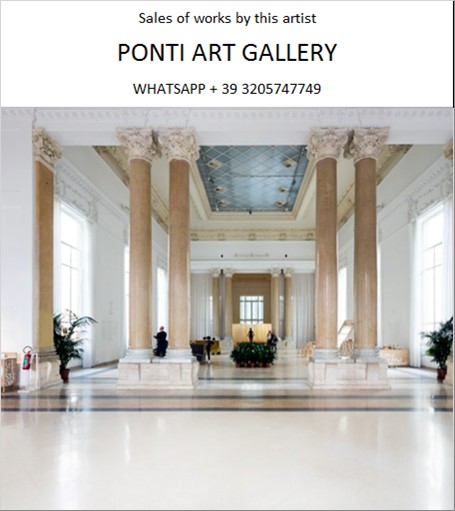Ponti Art Gallery is interested in buying and selling works
of art by this artist.

Jean Fautrier Biography
Jean Fautrier, born on May 16, 1898, in Paris, France, emerged as a pivotal figure in the development of modern art, particularly within the Tachisme movement, a French style of abstract painting that gained prominence in the 1940s and 1950s. His work, spanning painting, illustration, printmaking, and sculpture, reflects a profound engagement with the materiality of art and a relentless exploration of form and color. Fautrier's life and career, marked by innovation and a deep sensitivity to the human condition, offer a compelling narrative of artistic evolution against the backdrop of the tumultuous events of the 20th century.
Fautrier was the illegitimate child of an unwed mother and was initially raised by his grandmother. Following the deaths of both his grandmother and father in 1908, he moved to London to live with his mother. His artistic education began at the Royal Academy of Arts in 1912, but dissatisfaction with the rigid instruction led him to the Slade School of Fine Art, which was reputed to be more avant-garde. However, Fautrier found the teaching there equally unsatisfactory and decided to pursue his artistic development independently. His self-directed studies were significantly influenced by the works of J.M.W. Turner, which he admired during his visits to the Tate Gallery.
Fautrier's early career was interrupted by World War I when he was called up for the French Army in 1917. However, due to poor health, he was discharged in 1921 and returned to Paris, where he began to exhibit his work. His early exhibitions at the Salon d'Automne and the Fabre Gallery in 1923 marked the beginning of his professional career as an artist. During this period, Fautrier developed a distinctive style characterized by a tentative exploration of still lifes, nudes, and landscapes. His work from this time shows an admiration for Turner and an engagement with the Cubist palette, reflecting a broader search for a personal artistic language.
The outbreak of World War II had a profound impact on Fautrier's work. After a brief imprisonment by the German Gestapo in 1943, he fled Paris and found refuge in Châtenay-Malabry, where he began his most famous series, the Otages (Hostages). These works, inspired by the torture and execution of French citizens by the Nazis, represent a significant departure towards abstraction and are characterized by their haunting, skull-like forms and fleshy pastel tones. The Otages series not only marked Fautrier as a politically committed artist but also established him as a leading figure in the post-war Art Informel movement.
Despite his critical success, Fautrier remained a solitary figure, often preferring the company of writers and intellectuals over that of other artists. His work continued to evolve in the post-war years, exploring themes of pain, death, and the human form through a variety of media. Fautrier's late work is noted for its abstract qualities, often employing mixed media on paper to achieve subtle textural effects.
Fautrier's contributions to modern art were recognized during his lifetime with several prestigious awards, including the international grand prize at the Venice Biennale in 1960. He continued to work and exhibit until his death on July 21, 1964, in Châtenay-Malabry, France. His legacy is preserved through his influential body of work, which continues to inspire and challenge contemporary artists and audiences alike.
Throughout his career, Fautrier remained committed to pushing the boundaries of artistic expression. His exploration of texture, form, and color, coupled with his engagement with the political and social upheavals of his time, positions him as a critical figure in the narrative of 20th-century art. Fautrier's work, characterized by its intensity and emotional depth, invites viewers to confront the complexities of the human condition, making him a seminal artist whose contributions continue to resonate in the art world.
Jean Fautrier Quotes and Sales
of Works
Ponti Art Gallery selects and deals with paintings by the
artist. Upon request, we provide free estimates and
evaluations, communicate prices, quotations, and current
market values.
If you are interested in BUYING or SELLING works by the
artist, contact us immediately.
If you wish to sell or receive an evaluation of the
works:
Send us a frontal photo of the painting, one of the back,
and one of the signature. Also, indicate the dimensions of
the work. Inform us about the purchase origin of the work
and any kind of available documentation (purchase
receipts, certificates of authenticity, publications). One
of our operators will respond to you on the same day. We
guarantee maximum confidentiality and extreme
professionalism.
If you wish to purchase works by the painter: Contact us
and let us know your request. We will inform you about the
available works. We also offer the possibility to
subscribe to our NEWSLETTER, through which you will be
informed at the beginning of each month about the latest
acquisitions of the art gallery.
You can send us pictures of the work:
